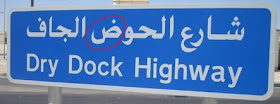This week we’ll start to look at the first of the four Arabic letters which are the hardest for non-native speakers to differentiate and pronounce: unfortunately for all of us, they all look and sound quite similar ...
So, this week we’ll look at the letter 'Saad' and next we'll look at the letter, 'Daad'. Then we'll continue with the other two letters which are really similar. The good news is, once you’ve learnt these four letters, the rest of the alphabet is easy ~a piece of cake~ and you’re two-thirds of the way through the alphabet. The bad news is, these four letters are bloody difficult.
If you haven’t already found a native Arabic speaker who's willing to help you achieve the correct pronunciation, now is the time to find one. These four letters have no equivalent in English, not even anything which is even vaguely similar!
There is some good news though, all four are connectors and so you’ll already know each of them have four different ways of being written; independent, initial, medial and final.
Speaking Saad
The sound for Saad needs to come from your lungs rather than your mouth and is made using the same technique as when you blow on your glasses to clean them. Blow on your glasses/sunglassses to make them steam up and make a sort of 'hhrrrh' sound whilst you’re doing it. Once you can do this, add an ‘s’ to the beginning of the sound and keep it deep and low. You should now be making a 'saarrrh' sound.
Once you can make the 'saarrrh' sound change the 'rrrh' at the end to a ‘d’ and make the saaad sound; saarrrd.Make sure when you say the letter 'Saad' you keep the sound as low as possible and that your tongue touches your top teeth.
Writing Saad
Thank goodness something is easy with Saad - the writing; start in the middle of the letter and move to the right, making a loop. Follow this with a tail shape (which ends above the line you are writing on). Make sure you keep your pen on the paper all the time, don’t lift up the pen between writing the loop and the tail, like so:
independent

Initial

Medial

Final

Examples of the Letter 'Saad'
The photos below all show the letter Saad in its various formats:
Initial



Medial


Final

Independent


Hide & Seek
Now see if you can find the letter Saad in the photos below:




Practice/ Homework
Should you wish to practice writing the letter 'Saad':
1.
Complete the hide and seek activities in the article above
2.
Using lined paper write the letter 'saad' in its four forms, as many times as you can; initial, medial, final and independent. A minimum of 20 repetitions is suggested.
3.
Re-read the previous wgaw blog posts {wgaw subject/ labels 'How to Read and Write Arabic} and try to find the letter Saad in the postings. Then decide which form the Saad appears.
Overview
1. The fourteenth letter of the Arabic alphabet is called, 'Saad'
2. The are four forms of the letter 'Saad'; initial, medial, independent and final
What's Next?
Next week we’ll look at Daad, the next letter of the alphatet and another letter which doesn't have an equivalent sound in English.







































